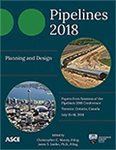Pipelines 2018
Sustainable Construction for Large Diameter Steel Pipeline on the Integrated Pipeline Project
Publication: Pipelines 2018: Planning and Design
ABSTRACT
After nearly four years of construction on several sections of the integrated pipeline (IPL) project in north Texas consisting of approximately 60 mi of 108-in steel pipeline using imported granular embedment, the existing soil conditions in IPL Sections 10 and 11 provided the contractor the opportunity to use native excavated material for a sustainable construction solution to importing embedment material. Most of the these completed sections of the IPL project were constructed in soils that were not conducive for use as pipe embedment without extensive screening and processing in the form of controlled low strength material (CLSM) for fat clay soils or crushing and screening of limestone. IPL Sections 10 and 11 which consists of approximately 12.5 mi of 84-in raw water steel pipeline in Ellis, Johnson, and Tarrant Counties partly runs through sandy soils that can be processed and mixed with cement to make cement stabilized sand (CSS). IPL Sections 10 and 11 begins in fat clay soils in the south and ends in the north and west in sandy soils. There are several sand borrow sites in the area including one that the pipeline runs through. This sand borrow site was active prior to construction of the pipeline. The contractor proposed using the native sandy soil excavated along the pipe alignment for CSS in lieu of gravel embedment. This paper highlights the steps taken to evaluate the use of the native sand for making CSS for pipe embedment: triaxial testing to determine Young’s modulus properties of various CSS sand mixes ranging from 1% to 5% cement content; determine modulus of soil reaction, E', values for each CSS mix design to confirm it’s suitability for a standard trench width; and require contractor to demonstrate that CSS could be produced from a pug mill with consistent quality that had optimum moisture determined as part of the triaxial testing process. By using native sandy soils excavated along the pipeline for producing CSS for the pipe embedment, the contractor was able to greatly reduce the number of embedment deliveries to the project site and reduce the amount of spoil material that had to be hauled off. This directly reduced the impact to existing roads and the environment.
Get full access to this article
View all available purchase options and get full access to this chapter.
REFERENCES
AWWA (American Water Works Association), (2004). Steel Pipe – A Guide for Design and Installation: Manual of Water Supply Practices – M11, Fourth Edition. AWWA, Denver, Colorado.
AWWA (American Water Works Association), (2005). Fiberglass Pipe Design: Manual of Water Supply Practices – M45, Second Edition. AWWA, Denver, Colorado.
AWWA (American Water Works Association), (2017). Steel Pipe – A Guide for Design and Installation: Manual of Water Supply Practices – M11, Fifth Edition. AWWA, Denver, Colorado.
Howard, Amster (1996). Pipeline Installation: A Manual for Construction of Buried Pipe. Relativity Publishing, Lakewood, Colorado.
Information & Authors
Information
Published In
Pipelines 2018: Planning and Design
Pages: 318 - 327
Editors: Christopher C. Macey, AECOM and Jason S. Lueke, Ph.D., Associated Engineering
ISBN (Online): 978-0-7844-8164-6
Copyright
© 2018 American Society of Civil Engineers.
History
Published online: Jul 11, 2018
Published in print: Jul 12, 2018
Authors
Metrics & Citations
Metrics
Citations
Download citation
If you have the appropriate software installed, you can download article citation data to the citation manager of your choice. Simply select your manager software from the list below and click Download.
